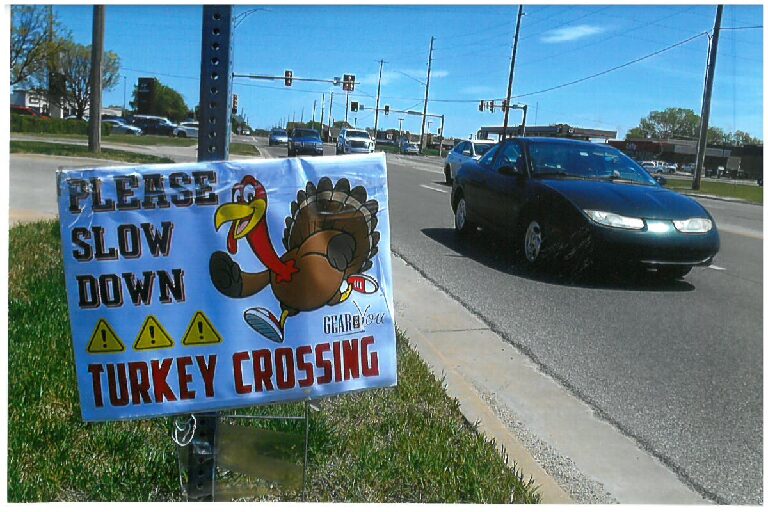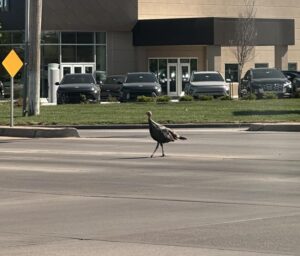A young Tom turkey has turned a busy intersection in east Wichita into his personal playground since earlier this year, catching the attention of motorists, businesspeople and others in the area with his antics.
He’s called Mr. G — for Gobbler — by employees at the Wheat State Credit Union, where he sometimes hangs out, and Ronald by employee of the Gear For You store, who admit they first nicknamed him Felicia.
“We thought he was a she,” Julie Hubl said. “Then someone asked if I saw the thing hanging down from his neck. I thought those were feathers, but that is his beard and marks him as a male.”
Technically he is a Jake, the name for an adolescent male turkey. And he’s apparently smitten with the intersection of Central Avenue and Greenwich Road.
Odds are he came from a rafter, or group, of turkeys living west of the runway at Textron’s plant nearby. His home now appears to be a cluster of businesses at the intersection: a credit union, sign shop, kitchen shop and atheltic gear shop.
Hubl’s co-worker, Heather Cox, said the entire neighborhood looks out for him. And they need to. “He’s kind of ornery,” Cox said, describing his propensity for “standing in the busy street, chasing cars and pecking at their hub caps as they drive by.”
Why is he there? The women in the store aren’t certain. Hubl said someone told them he might have been expelled from the rafter by an older, bigger male.
However, Charles Cope, who at age 74 still works as district wildlife biologist for Sedgwick, Harvey and Sumner counties, thinks otherwise.
“He may just be working off some excess energy,” Cope said.
A high chain-link fence surrounds the Textron airport where most of the birds live. But turkeys fly, and the fence wouldn’t keep the bird away from the business district.
Turkeys have a pecking order like chickens, Cope said. But he knows of many flocks where older and younger males live peacefully together. (One Reno County rafter he knows of has 700 birds, another about 300.)
As for Mr. G/Ronald’s habit of chasing after cars and people, Cope said, “When turkeys sense fear, and most wildlife do have that sense, they may chase a person.” And no one or thing can hide well from a turkey. “A wild turkey’s vision is about three times better than a human’s and the bird can see eight time a far.”
Fortunately for him, motorists so far have taken pains to avoid him. “One driver was even backing up in traffic on Central” to protect the bird, Hubl said.
But the turkey spooked at least one customer. “She called from her car in the parking lot to ask if we could make him move. She was terrified. So I went to her car and walked inside beside her,” Hubl said.
Cope said biologists discourage feeding wildlife. That hasn’t stopped workers in the area from dropping snacks like corn outside their buildings. Others do, too. “Some people stop here just to leave food for the bird,” Cox said.
Food, however, has not made him tame. “He watches me if I have food but backs away if I get close,” Cox said.
The east Wichita bird is an Eastern Turkey, one of three breeds that live in Kansas. Birds like Mr. G/Ronald often weigh about 30 pounds, although a domestic male might reach 80 pounds. Cope says native wild turkeys were once hunted nearly to extinction, but their numbers revived in recent years.
Turkeys now live in some Wichita parks such as Pawnee Prairie Park and the Great Plains Nature Center, Cope said.
According to experts, urban wildlife populations are growing faster than those outside the towns, probably because there are fewer predators and more food. “Like people, wildlife needs four things — food, water, shelter and space,” Cope said.
Not everyone is a fan of wildlife in towns. Cope’s office responds to wildlife complaints — like the turkey standing on the roof of a home pecking at shingles to get insects for food.
Unfortunately for turkeys or any unwelcome wild guest, if the animal can’t be removed in any other way, rules require that it be euthanized.
But Mr. G/Ronald seems to have found a home for now.
Contact Bob Rives at bprives@gmail.com.










